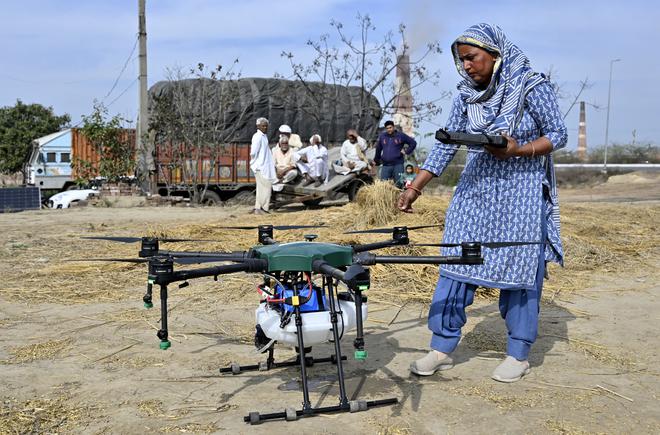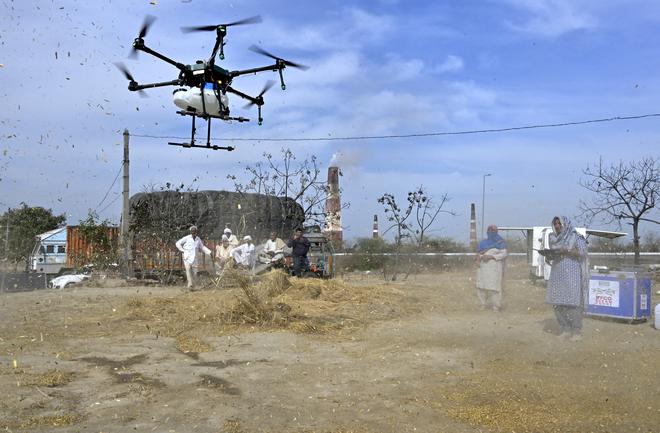A month before farmers began their protest along the Punjab-Haryana border, with the police dropping tear gas shells from drone-based launchers, Ram Raji, 36, had been issued a drone and an electric autorickshaw by a fertilizer company. Raji and several women like her were to spray liquid pesticide over the ripening wheat crop. But when the protests broke out, the drone operator from Qila Zafargarh village in Haryana’s Jind district was disappointed.
“There was a 12-day Internet shutdown in the districts bordering Punjab and Haryana, including Jind. While working in the fields, I need an Internet connection for the GPS signal connecting to the drone,” she explains, standing in front of a field of wheat, and locking an acre to be sprayed on her remote control. February is a crucial month for spraying nano urea over the wheat crop, right before it flowers, and now, farmers feel it’s too late, Raji says. Each workday lost also means a loss of income.
Raji is one of the initial 1,000 drone didis selected by fertilizer companies from across India to be trained under the Central government’s Namo Drone Didi scheme to fly agricultural drones that will spray fertilizers over crops. Armed with a pilot’s licence from the Directorate General of Civil Aviation (DGCA), they are meant to be seen as changemakers.
In November last year, Prime Minister Narendra Modi announced the decision to engage 15,000 women from rural self-help groups (SHGs), at an approved outlay of ₹1,261 crore, to cover the cost of drones and battery sets. This amount has not yet been spent, says a Central government official working closely with the scheme.
Over two months after the announcement, Mr. Modi is slated to interact with the first 1,000 drone didis on March 11. However, officials say exact modalities and the future road map are still unclear. “The government has planned for another 6,000 drone didis to be trained in 2024-25, and another 8,000 in 2025-26,” the official says.
Costs to companies
The official adds that the cost of training the first batch of drone didis, equipping them with the drone and its components (four battery sets, a generator), and an electric autorickshaw is being borne by fertilizer companies like Indian Farmers Fertiliser Cooperative Limited (IFFCO) and Coromandel International Limited (CIL).
“IFFCO is supporting training and supply of equipment worth ₹42 crore at the rate of ₹14 lakh per woman, including the electric autorickshaw for 300 drone didis, while CIL is supporting another 200,” the official adds. IFFCO has cited this expense as “benefits to farmers” in its books.
Among other companies that have assured a joint supply of 500 additional drones are Krishak Bharati Cooperative (KRIBHCO), Indian Potash Limited (IPL), Matix, Indorama India Private Limited, Brahmaputra Valley Fertilizer Corporation Limited, and the public-sector National Fertilizers Limited.
“The cost for each set of equipment (including a drone, four battery sets, a generator; excluding the electric autorickshaw) is ₹10 lakh, of which the Ministry of Agriculture and Farmers Welfare has agreed to fund up to ₹8 lakh, while ₹2 lakh will have to be arranged by the SHG,” says the official, referring to the drone didis who will be trained after the first batch.
Influencer marketing
The Haryana government will foot the bill for the service provided by the drone didis, promising them ₹400 for every acre sprayed. No other State has offered this. “In Punjab, Uttar Pradesh, Andhra Pradesh, and Telangana, farmers must spend their own money for spraying,” the Central government official says.
Raji was given a target of covering 257 acres in Julana block over two months. Her counterpart, Kavita Dhull, 35, in Rohtak district, had a target of 800 acres, of the 4,000 acres to be covered exclusively by drone didis out of the total two lakh acres.
However, in 40 days of work, between January 14 and February 25, Raji has been able to cover only 180 acres, averaging 4.5 acres per day, where she was supposed to cover six to eight acres every day. She is helped by her brother-in-law, who drives the electric autorickshaw and assists her in operating the drone. “We are incurring EV charging costs and labour costs and are spending from our own pockets. We hope the promised reimbursement comes through in March,” Raji says.

The Drone Didi project is a subset of the Centre’s Lakhpati Didi programme, formulated for women from SHGs to earn an annual household income of ₹1 lakh. The aim is for the women to be influencers, both at home and in their communities, shifting the focus from social and financial inclusion to entrepreneurial success. The Prime Minister, through his Sunday radio broadcast, Mann Ki Baat, often refers to ‘lakhpati didis’. It also found mention in Finance Minister Nirmala Sitharaman’s interim Budget speech this year, and appears in advertisements put out by the government.
Farmer trials
To encourage farmers to apply to get their crops sprayed via drones, Haryana’s Agriculture Department, along with fertilizer companies, announced enrolment through the online portal, Meri Fasal Mera Byora. Farmers would also get a one-litre nano urea bottle at ₹100, instead of the ₹225 marked on the bottle, and a drone didi would be allotted to visit the fields for spraying. One bottle, mixed in 10 litres of water, serves an acre.
Kuldip Singh Hooda, 40, is among a minority of 1,000-odd farmers in Dhamar village, Rohtak district, who has a substantial landholding of 15 acres. Most others own land between two and four acres. “I had registered to get 15 acres sprayed. However, the drone didi who came sprayed six acres and said she didn’t have the time to do the rest. No one came again to spray the other nine acres,” he says.
Farmers in Haryana had a difficult 2023. Their rice crops were destroyed due to heavier than usual rain during the monsoon, between July and August. “Half our annual income has been washed away,” says Manjit Hooda, another farmer from Dhamar village. Manjit says he had tried registering on the portal, but his application did not go through; no one contacted him either.
For farmers to avail themselves of the subsidy, their farm will have to fall under the earmarked acreage allotted to drone didis, or else they will have to shell out ₹400 per acre. Many who are debt-ridden or those with small landholdings prefer to do the job manually, themselves or through less-expensive hired labour.
Traditionally, farmers procure granular urea in sacks, each sack of 50 kg at a subsidised rate of ₹268. Labour costs for manual application is between ₹80 and ₹100 per acre, making the cost of fertilizer purchase and application no more than ₹368 per acre. If they choose to use the water-based medicine through spray cans, the application is still ₹200 per acre, half of what the drone didis charge. “Drones then will only be useful on large plantations like that of coffee, tea, or sugarcane, to make it cost-effective,” the government official says.
“A big landowner can afford drones, but there are only five to 10 such rich farmers in the village,” says Harinder Singh, in his mid-40s, who owns two acres and farms on another 17 acres leased out from another landowner. “I don’t have enough money to build my own house, buy a tractor, or send my children to a good school. What use are drones for me?” he says.
The women’s challenges
Dhull makes her way down a bumpy kuccha road of Dhamar village along with her assistant, who drives the electric autorickshaw, and then helps her unload the heavy metal box that contains the 25-kg drone.
“I cannot venture into the fields alone, because of safety concerns. I need a helper who can drive the EV. The vehicle does not easily reverse, and has even toppled over. The drone weighs nearly 30 kg after being loaded with fertilizer and water. It takes two people to lug it around,” Dhull says. She pays her assistant ₹15,000 a month. “There is no provision for helpers in the scheme,” she says.
As soon as she covers three acres, she exhausts one charged battery set needed to fire up the drone. She simultaneously charges another set in her EV to cover more ground. Dhull ends up charging four battery sets each day to finish her day’s work on the field. “I spend nearly ₹500 to ₹600 each day on fuel to run the generator that charges the battery sets.” She isn’t sure how the job will work out economically in the long run.
On paper though, the earnings are large: if each drone didi covers 20 acres a day for 200 days, her earnings, at ₹300 to ₹400 per acre, will be ₹12-₹16 lakh per year.

Push for pesticide
India uses 3.5 lakh metric tonnes (MT), or 65 crore bags, of granular urea annually, of which 2.95 lakh MT is met with domestic production, while the remainder is imported. The Central government then extends ₹2.45 lakh crore in subsidy to make granular urea bags affordable for farmers. Only 7.42 crore bottles of liquid nano urea have been manufactured in the last two years. Manufacturing liquid nano urea costs ₹225 per bottle, while granular urea costs ₹2,000.
“Our vision is to augment the capacity of nano urea production to 48.5 crore bottles annually by 2026-27, so that we can reduce our dependence on the import of expensive granular urea,” the government official explains. However, liquid nano urea (which is sprayed by drones or by the knapsack method) cannot completely replace traditional granular urea, as farms need fertilizers thrice in every crop cycle. Liquid can be sprayed only once, as only granular urea is effective at the sowing stage, and a fertilizer can only be used at the roots once the flowering begins, they add.
Many questions remain to be answered. “For instance, who will have the ownership of the drone? Will it be with the individual, the SHG she belongs to, the village organisation (VO) under which the SHG comes, or the cluster level federation (CLF) that consists of many village organisations?” says a source working in the Namo Drone Didi implementation committee. Again, there isn’t clarity around future earnings. Will the money be the woman’s or will some of it flow to the SHG, VO, or CLF?
Last year, the Agriculture Ministry had floated a proposal for procuring 300 drones under Krishi Vigyan Kendras (KVKs), centres attached to agricultural universities that conduct research. “While some KVKs are using drones, others are not. Before announcing another drone-related scheme, it would have been important to understand the learnings of KVKs while using drones,” an official from the Agriculture Ministry added. “Also, farmers are free to buy their own drones, so imagine if a few farmers band together to buy their drone, it will eat into the business of drone didis,” the official adds.
Meanwhile, Dhull has sprayed nearly 600 acres in Rohtak, and is now waiting for her money to be reimbursed by the Haryana government for her services. Now that the wheat is flowering, there is a lull in work for two months. “Let’s see when we will get paid,” she says.







